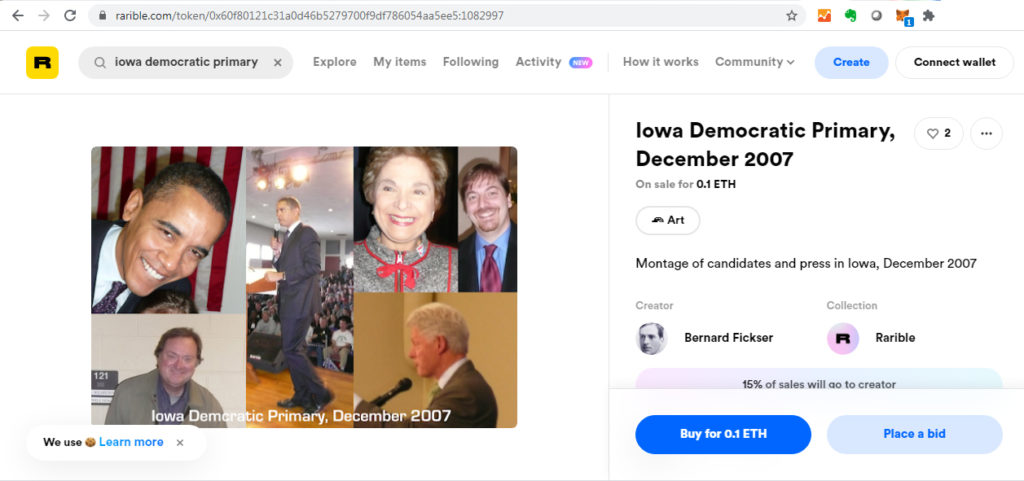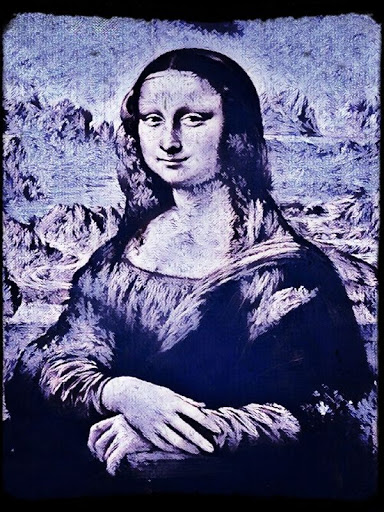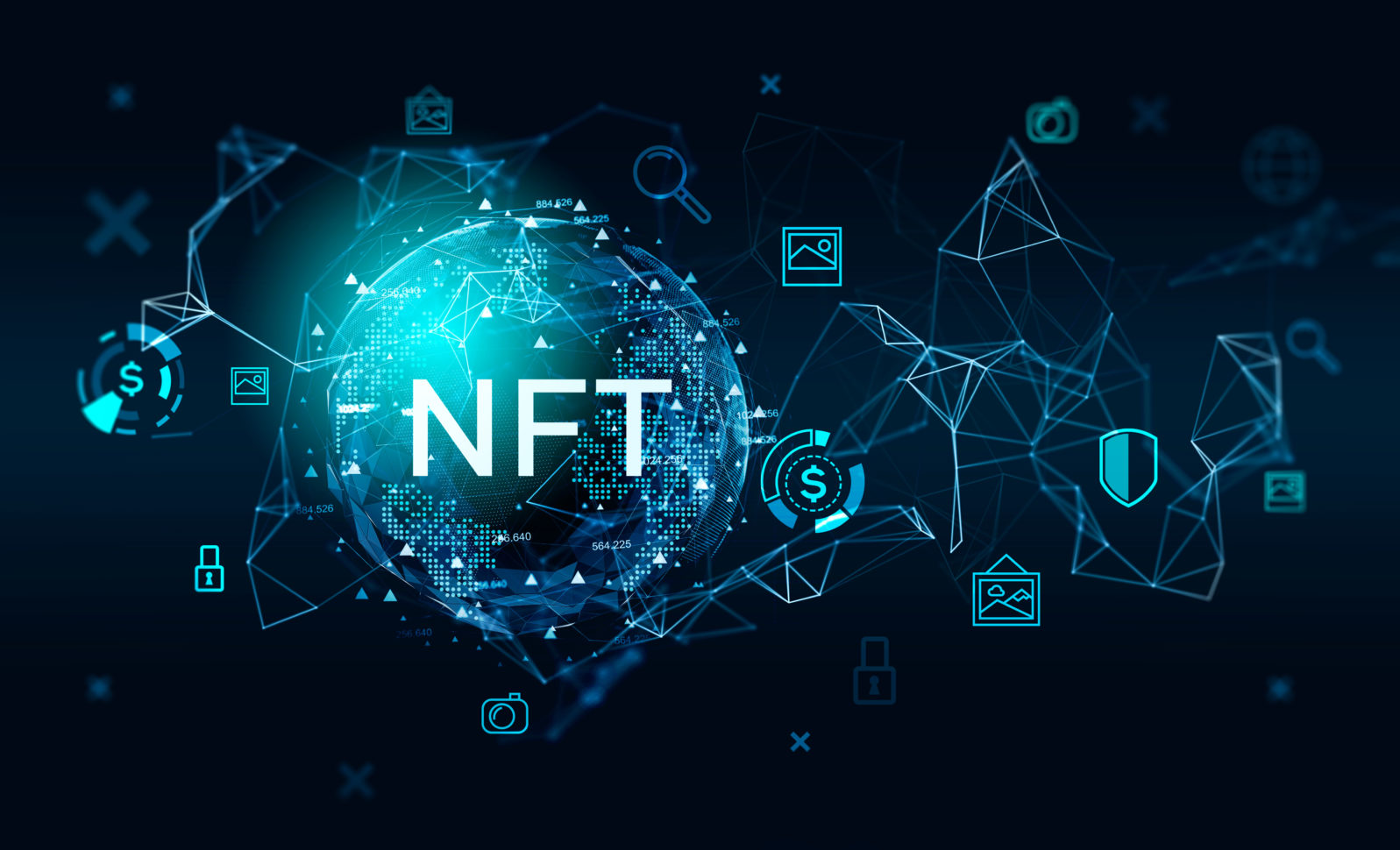How To Create Non-Fungible Tokens (NFTs), Simplified
While still deeply skeptical of what ownership of an NFT really means at present, Fickser decided to experiment with creating, buying, and selling NFTsIntroduction: At Expensivity, Bernard Fickser explains that a non-fungible token (NFT) is a unique token in cryptography that represents, say, real estate or art rather than money. Because the tokens have unique identities (non-fungible), they can be bought or sold while reducing the risk of fraud.
So how do they work?: The series is called How Non-Fungible Tokens Work: NFTs Explained, Debunked, and Legitimized (July 30, 2021). In Part 3, Fickser demonstrates the do-it-yourself minting of NFTs.
3 The Do-It-Yourself Minting of NFTs
The process of creating NFTs, along with buying and selling them, is simple and straightforward. All that’s required is
- setting up a crypto wallet that handles Ethereum cryptocurrency (ETH),
- loading it with some of that currency,
- visiting an NFT marketplace (a third party that accesses the Ethereum blockchain),
- connecting the crypto wallet to that NFT marketplace, and
- create/upload/sell or else buy an NFT by spending some cryptocurrency at the marketplace.
Since it’s always better to actually see how something is done than merely to describe it, I’m next going to provide two helpful YouTube videos and then walk readers through the creation, sale, and purchase of an NFT by me.
3.1 Two How-To Videos on NFTs
The following two YouTube videos lay out “how to do it.” The first is a bit more general, the second gets more into the nuts and bolts of turning art into NFTs. The videos are about 15 minutes each. They’ve had many views. They’re worth watching carefully, not only for the how-to instruction but also to understand the motivations underlying the creation and monetization of NFTs:
3.2 A Selective Montage of the 2007 Iowa Democratic Primary
The NFT that I’m going to create, upload, and put up for sale will be a montage of the Iowa Democratic primary for the US presidency from over a decade back. As it is, my family was in Iowa in December 2007, and it was a wild time in the lead-up to the 2008 presidential election. My wife and daughter attended numerous rallies and got some great pictures of candidates and press. Here’s a montage of some of the pictures my wife took (many of them were with the candidate or journalist next to my daughter, whom I cropped out for privacy reasons). The associated png source file on this website is given in the caption.

3.3 Turning This Montage into an NFT
Let’s now go step by step in turning this montage into an NFT:
3.3.1 GET CRYPTOWALLET
Get yourself a cryptowallet that can handle Ether (ETH). I already had an Electrum wallet for Bitcoin. For ETH, I went with MetaMask: https://metamask.io/. This wallet seems to have a large following. It’s also got an app that works well with my iPhone. Additionally, it integrates readily into Chrome, which is my go-to browser (a point of ambivalence for me given my misgivings about surveillance capitalism).
Using the MetaMask wallet is reasonably straightforward, but do a Google query if you get stuck. For instance, I ran into a problem when it wasn’t clear whether I needed to get into Chrome settings or the MetaMask settings (the latter are not clearly marked and are accessed by clicking on the top right icon).
Once you get your wallet set up, you’ll see a sequence that looks like this (which happens to be the one in my wallet):
0x4f74085dfE2f580BaAb770b0DA9c41E6f38E065F
That’s the public address. It’s readily copied by hovering over it and hitting “copy to clipboard.” You’ll need this address for people to send you Ether, to send yourself Ether to load onto the wallet, and to pay for setting up an NFT.
Two caveats regarding the MetaMask wallet, and crypto wallets in general, are worth bearing in mind:
- All this convenience with the MetaMask wallet comes at a security cost. For instance, in this age of unbridled surveillance, easy integration of the wallet into Google Chrome seems hardly a recipe for privacy (Google being second in surveillance perhaps only to the National Security Agency). I’m therefore leaving just enough Ether in my MetaMask wallet to cover the costs of this exercise of showing how to work with NFTs. So if I lose everything in this wallet, I can live with that. But if you put a serious amount of Ether into a cryptowallet, I would probably work exclusively with the Brave browser (given its commitment to anti-tracking) and a VPN. I’d also get a crypto hardware wallet (such as the Trezor or Ledger, available on Amazon). The advantage for security with these hardware wallets is that it keeps you offline as much as possible, limiting attacks from cybercrooks (although not eliminating all attacks because you still need to get online to work with cryptocurrency).
- Be sure to keep good track of your 12-word seed phrase when you set up your wallet. If you lose it, you lose your wallet and everything in it. It’s often suggested that you write down the seed phrase on paper and keep it entirely out of digital reach. But paper is easily misplaced, and the news is filled with people who have lost a lot of cryptocurrency by forgetting or misplacing their seed phrase. Here’s one 2021 headline from Business Insider: “People have lost roughly $140 billion in Bitcoin because they forgot their passwords or got locked out of accounts, and would-be millionaires are struggling to access their wallets.” I therefore prefer to record the seed phrase in an image file, and then hide the image among a plethora of other images where it gets hidden from view unless you know what you’re looking for.
3.3.2 BUY ETH/ETHER
The next thing to do is buy some ETH/Ether. The MetaMask wallet tries to make this convenient by allowing you to buy Ether directly through Wyre. But Wyre was not supported in my state. So the surer course will be to work through an exchange, buy some Ether there, and then transfer the Ether to your wallet using your wallet’s public address.
Coinbase.com is the most popular exchange, and I’ve got an account there. But I bought some Bitcoin and Ethereum there in 2016 when the cost of both was ridiculously low compared to today, and I didn’t want to generate a “tax event” by using that account in this exercise of NFT creation. Other exchanges exist and also work well. Kraken.com is solid, but you have to wire money into your account there before you can use it.
Gemini.com (run by the Winklevoss twins) has higher transaction fees, but works quickly with a debit card. I used it in this exercise. Buying and moving the Ether from Gemini.com to my MetaMask wallet took maybe two minutes. I had, however, confirmed my debit card beforehand with Gemini.com. For confirmation, Gemini.com made two small reversible deposits into the bank account of the debit card. I then had to verify those amounts with them. This was also handled quickly (minutes, not hours).
3.3.3 VISIT NFT MARKETPLACE
In connecting to an NFT marketplace, you have a range of choices. Popular NFT marketplaces include:
Some of these marketplaces cover the full range of NFTs, such as Open Sea. Others are more specialized. MythMarket, for instance, focuses on trading cards. SuperRare, as the name implies, strives to be more selective, listing NFT creators only after first accepting them to its platform via an artist profile submission form.
I would urge readers of this article to browse all these sites to get a feel for how these marketplaces work and what NFTs are really like. For me, the overwhelming impression I get from browsing these platforms is that they make a virtue out of promoting ugliness, triviality, insipidness, sensory overload, and unoriginality (notably the kluging and repackaging, via photoshop and similar technologies, of existing digital items).
For a revealing contrast, I would urge readers also to visit the art auction houses of Sotheby’s or Christie’s. Granted, NFTs are now being sold at these auction houses as well, but have a look at this Sotheby’s auction of American art or this Christie’s auction of 19th century European art. Not only are you at these auctions buying unique items of art that cannot be replicated, but once you buy them and take delivery, you own them in every conceivable sense. For instance, once they’re in your possession, you can take photos of them, and the photos will be under your copyright.
In any case, to create my NFT from the montage of photos taken in December 2007 at the Iowa Democratic Primary, I decided to go with Rarible. Rarible is large as these NFT marketplaces go. It requires no invitation to use their services, and set up is straightforward.
3.3.4 CONNECT CRYPTO WALLET
Once at Rarible.com, connect to your crypto wallet by clicking on the “connect wallet” button in the upper right. If you’re using Chrome, MetaMask will be the first option you see. Connect to this wallet if you have it. Otherwise use a different wallet. If you’re in another browser such as Brave, Rarible will give you options for connecting a non-MetaMask wallet. Use one of those options.
First time around, you’ll be asked for a MetaMask password or you may be asked for your entire seed phrase. Once you get your wallet connected, set up a profile in your name with Rarible. The profile requires just a few items, and you can edit it later at your convenience.
3.3.5 CREATE OR BUY NFT
With your wallet connected and some Ether in it to cover costs, now either create a new NFT at Rarible or else buy an existing NFT. We’ll do both.
To create an NFT, I’ll use the png above that’s the montage of politicians and press at the 2007 Iowa Democratic Primary. The image file is about 2MB. To turn this png into an NFT, hit “create” in the upper right menu at Rarible. You then need to hit either “single” or “multiple” depending on whether you want a one-of-a-kind NFT or one that has a fixed number of copies. For my NFT, I chose “single.”
Next, upload your image or other digital file. I uploaded my png, and then filled out the requested information. I chose “fixed price” and set the price for this NFT at .1 ETH, or by today’s exchange rate at about $230. You could also have gone with a timed auction in which you set a minimum price and time for the auction (much as at eBay). You could as well have chosen an unlimited auction (which is unexplained on the site but means an auction that simply runs until you call it). And finally, you have the option of uploading the NFT but not putting it up for sale.
Title and description of my NFT were at my discretion. I titled it “Iowa Democratic Primary, December 2007.” I went with a 15 percent royalty, so that whenever the NFT is sold subsequently, I’ll see 15 percent of the selling price (10 percent seems to be the default). With regard to choosing the collection (ERC vs. RARI), I went with RARI since it was the easier option (the ERC option required some additional identifiers for putting the NFT on the Ethereum blockchain).
Finally, there’s the issue of lockable content. For simplicity, I went with not activating the “unlock once purchased” option. By not activating this option, I made the full png of my NFT available at Rarible, as you can see here (the png that Rarible exhibits is thus identical with the one on this website given above):
https://rarible.com/token/0x60f80121c31a0d46b5279700f9df786054aa5ee5:1082997?tab=details
But I could also have gone with the option to “unlock once purchased.” The result of doing so is explained on the Rarible FAQ page:
As a content creator, you can add unlockable content to your collectibles, that only becomes visible after a transfer of ownership (i.e. selling or gifting your NFT). Artists use this feature to include high res files, making ofs, videos, secret messages, etc.
By uploading the digital file that’s being transformed into an NFT and then answering the other questions, you now just need to hit “create item.” From there it’s simply a matter of telling your wallet to authorize three steps: 1) mint, 2) approve, 3) set fixed price. The first two of these will debit your crypto wallet, which for me came to about $23 in ETH given the exchange rate that day. Once you complete these authorizations, your NFT will be created. Mine is at the Rarible link given above. Here is a screenshot:

That’s all there is to creating a new NFT. So long as you have a compatible ETH-based wallet with sufficient Ether in it, and so long as the digital file that you are turning into an NFT is readily available for upload, creating a new NFT is straightforward and takes but a few minutes.
Finally, buying an NFT is even simpler. Because I’m deeply skeptical of what ownership of NFTs on the Ethereum blockchain even means, I decided to go with the cheapest NFT I could find at Rarible. This was the following image of the Mona Lisa:

The stated cost was .003 ETH, which at the rate of exchange at the time came to about $7. But there was also a .0063 ETH “gas fee,” which is the service cost paid to Ethereum miners for inputting transactional information onto the Ethereum blockchain. By the exchange rate at the time, that came to another $15, so that buying this NFT ended up costing me three times its asking price ($22). For the time being, I’m not putting this NFT up for sale.
In one respect, creating an NFT proved more straightforward than buying an NFT. Once I hit “create item,” the NFT I created (the Iowa montage) got registered under “my items” on the Rarible site almost immediately. On the other hand, when I bought the Mona Lisa NFT, I saw an animation with confetti congratulating me on the purchase, but when I looked under “my items” on the Rarible site, I didn’t see anything related to the NFT until about half an hour later, at which point my ownership was finally acknowledged.
So in the interim between attempting to buy the Mona Lisa NFT and actually taking possession, there was nothing I could find on the Rarible site to indicate that my purchase had gone through or that my possession of the NFT was pending (thus causing me to wonder if the purchase was successful at all). So, presumably, it wasn’t until the Mona Lisa NFT was fully transferred to my address on the Ethereum blockchain, about half a hour later, that my purchase appeared under “my items” at Rarible. Be aware, therefore, that purchases of NFTs may experience a lag of the sort that we’re not used to with conventional vendors (such as eBay or Amazon).
Next: 4 NFTs: You bought one. But do you really own it? Could you ever?
Here are all the parts of the series, 1 through 7:
Part 1: Cryptography: Are non-fungible tokens a scam? Or can they work? By Warren Buffett’s logic, if cryptocurrencies are rat poison squared, non-fungible tokens are rat poison to an infinite power. But is that all there is to be said about them? Blockchain technology allows for digital collectibles to be scarce even if they are replicable, thus creating value, like Jack Dorsey’s famous initial tweet.
Part 2: Can digital signatures protect NFTs in digital marketplaces? The concept of owning an NFT on a blockchain is specific to the blockchain with no legal force in society at large. While NFTs are new, the debasement of value by proliferating copies whose marginal value is close to zero has a long and ignominious history.
Part 3: How to create non-fungible tokens (NFTs), simplified. While still deeply skeptical of what ownership of an NFT really means at present, Fickser decided to experiment with creating, buying, and selling NFTs. Bernard Fickser offers a step-by-step explanation, offering an original montage of the Democratic primary in Iowa in 2007 for sale as an illustration.
Part 4: NFTs: You bought one. But do you really own it? Could you ever? Right now, the non-fungible tokens markets leave a lot to be desired as a business proposition, Bernard Fickser explains why. The current NFT regime features no limit on proliferation, no guarantee of scarcity, and terms that disclaim any accountability on the part of the NFT market.
Part 5: In the digital world, what does “scarcity” mean? For a digital artwork like Beetle’s Everydays, which sold for over $69 million, a number of methods are used to prevent copying, thus ensuring uniqueness. Three methods used to ensure uniqueness include partial availability (for fair use), digital marking, and algorithmic immutability (like blockchain).
Part 6: What makes NFTs valuable? What does it mean to own one? In the case of non-fungible tokens (NFTs) on the Ethereum blockchain, actual ownership with legal standing is never in fact transferred for the underlying digital file. Bernard Fickser points out that the NFT literature is filled with equivocations about the meaning of the word “own” as it relates to NFTs.
Part 7: How can non-fungible tokens (NFTs) be made to work better? Bernard Fickser offers twelve steps to handling NFTs in a way that dispenses with cryptocurrency-based blockchains and works in ordinary online marketplaces like eBay. In Fickser’s view, NFTs can work if they avoid self-serving cryptocurrency blockchains like Ethereum and enable real-world legal transfers of ownership.
Also: Jonathan Bartlett’s response: Blockchains have NFTs unnecessarily tied down. New ideas propose severing the accidental relationship between NFTs and blockchains. For NFTs, the blockchain is actually reducing the value of the NFT, as it introduces additional dependencies and costs for maintaining NFTs
